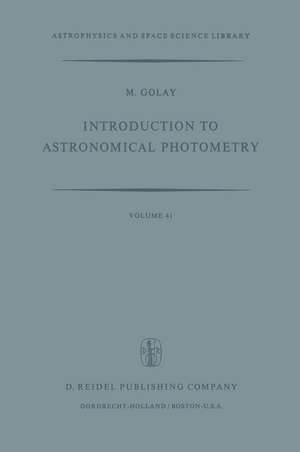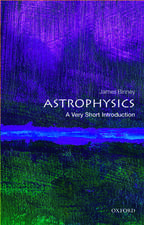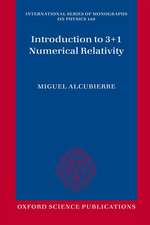Introduction to Astronomical Photometry: Astrophysics and Space Science Library, cartea 41
Autor M. Golay Traducere de G. J. Thornleyen Limba Engleză Hardback – 30 sep 1974
| Toate formatele și edițiile | Preț | Express |
|---|---|---|
| Paperback (1) | 948.47 lei 43-57 zile | |
| SPRINGER NETHERLANDS – 5 noi 2011 | 948.47 lei 43-57 zile | |
| Hardback (1) | 801.38 lei 38-44 zile | |
| SPRINGER NETHERLANDS – 30 sep 1974 | 801.38 lei 38-44 zile |
Din seria Astrophysics and Space Science Library
- 24%
 Preț: 799.08 lei
Preț: 799.08 lei - 15%
 Preț: 647.92 lei
Preț: 647.92 lei - 18%
 Preț: 983.81 lei
Preț: 983.81 lei - 18%
 Preț: 790.28 lei
Preț: 790.28 lei -
 Preț: 359.85 lei
Preț: 359.85 lei -
 Preț: 389.70 lei
Preț: 389.70 lei - 20%
 Preț: 691.13 lei
Preț: 691.13 lei - 20%
 Preț: 816.17 lei
Preț: 816.17 lei - 18%
 Preț: 1011.27 lei
Preț: 1011.27 lei -
 Preț: 402.56 lei
Preț: 402.56 lei - 15%
 Preț: 664.93 lei
Preț: 664.93 lei -
 Preț: 398.15 lei
Preț: 398.15 lei - 18%
 Preț: 954.77 lei
Preț: 954.77 lei -
 Preț: 411.04 lei
Preț: 411.04 lei - 18%
 Preț: 1225.31 lei
Preț: 1225.31 lei - 18%
 Preț: 1843.29 lei
Preț: 1843.29 lei -
 Preț: 393.13 lei
Preț: 393.13 lei -
 Preț: 400.26 lei
Preț: 400.26 lei - 18%
 Preț: 953.82 lei
Preț: 953.82 lei - 18%
 Preț: 960.61 lei
Preț: 960.61 lei -
 Preț: 398.35 lei
Preț: 398.35 lei -
 Preț: 390.84 lei
Preț: 390.84 lei -
 Preț: 413.76 lei
Preț: 413.76 lei -
 Preț: 416.64 lei
Preț: 416.64 lei - 18%
 Preț: 947.67 lei
Preț: 947.67 lei -
 Preț: 404.51 lei
Preț: 404.51 lei - 18%
 Preț: 956.50 lei
Preț: 956.50 lei -
 Preț: 403.75 lei
Preț: 403.75 lei - 18%
 Preț: 1229.40 lei
Preț: 1229.40 lei - 18%
 Preț: 1224.99 lei
Preț: 1224.99 lei -
 Preț: 404.29 lei
Preț: 404.29 lei - 15%
 Preț: 654.77 lei
Preț: 654.77 lei - 18%
 Preț: 1248.20 lei
Preț: 1248.20 lei - 18%
 Preț: 955.25 lei
Preț: 955.25 lei - 18%
 Preț: 1846.28 lei
Preț: 1846.28 lei - 18%
 Preț: 1233.06 lei
Preț: 1233.06 lei - 18%
 Preț: 1234.77 lei
Preț: 1234.77 lei
Preț: 801.38 lei
Preț vechi: 1054.45 lei
-24% Nou
Puncte Express: 1202
Preț estimativ în valută:
153.34€ • 160.53$ • 126.88£
153.34€ • 160.53$ • 126.88£
Carte tipărită la comandă
Livrare economică 02-08 aprilie
Preluare comenzi: 021 569.72.76
Specificații
ISBN-13: 9789027704283
ISBN-10: 9027704287
Pagini: 380
Ilustrații: IX, 366 p.
Dimensiuni: 160 x 240 x 26 mm
Greutate: 0.7 kg
Ediția:1974
Editura: SPRINGER NETHERLANDS
Colecția Springer
Seria Astrophysics and Space Science Library
Locul publicării:Dordrecht, Netherlands
ISBN-10: 9027704287
Pagini: 380
Ilustrații: IX, 366 p.
Dimensiuni: 160 x 240 x 26 mm
Greutate: 0.7 kg
Ediția:1974
Editura: SPRINGER NETHERLANDS
Colecția Springer
Seria Astrophysics and Space Science Library
Locul publicării:Dordrecht, Netherlands
Public țintă
ResearchCuprins
1. General Definitions and Energy Distribution for Various Spectral Types.- 1.1. Definition of Photometric Measurement, A Special Case of Astronomical Measurement.- 1.2. Description of the Energy Distribution in Stellar Spectra.- 1.3. Characteristic Physical Parameters of the Continuous Energy Distribution.- 1.4. Characteristic Parameters of the Energy Distribution.- 1.5. The Importance of Lines in Photometric Measurement.- 1.6. Distribution of the Fraction of Energy Absorbed in the Lines.- 1.7. The Importance of Accuracy when Making Measurements in Astronomical Photometry.- 1.8. Interstellar Absorption Law Deduced from Spectrophotometry.- 2. Photometric Measurements, Effects of Bandwidths and Interstellar Absorption.- 2.1. Characteristic Parameters of a Photometric System.- 2.2. Atmospheric Extinction Correction. Role of the Bandwidth.- 2.3. Effect of Bandwidth on Corrections for Interstellar Extinction.- 2.4. Effects of the Bandwidth and the Form of Extinction Law on Ratios of the Type Eu/Ey.- 2.5. Effects of Various Extinction Laws and Bandwidths on Ratios of the Type Av/Ey.- 2.6. Relationships between Heterochromatic Magnitudes Obtained from Two Similar Systems.- 2.7. Relationships between the Colour Indices of Two Similar Photometric Systems.- 2.8. Comparison oF The Ratios Eu/Ey and Av/Ey for Two Similar Photometric Systems.- 3. Two-Dimensional Photometric Representations of Stars.- 3.1. Relationship between Colour Indices and Gradients.- 3.2. Colour Index and the Balmer Discontinuity.- 3.3. Two-Dimensional Photometric Representation of Stars: Introduction to the UBV System.- 3.4. Interstellar Reddening Lines in the UBV Diagram.- 3.5. Position of the Black-Body and other Radiation Laws in the UBV Diagram.- 3.6. Effect of Binarity in UBV Diagrams.- 3.7. Dispersion Caused by Rotation.- 3.8. Blocking and Blanketing Effects inUBV.- 4. Multi-Colour and Wide-Band Photometry.- 4.1. Comparison between the UBV and RGU Systems.- 4.2. Information Growth by Increasing the Number of Passbands.- 4.3. Description of Energy Distributions Using a Photometry Having n Wide Passbands.- 4.4. Use of Multi-Colour Photometric Systems in Describing the Interstellar Extinction Law.- 4.5. Introduction of Linear Combinations of Indices.- 4.6. Linear Combination of Heterochromatic Indices and Interstellar Extinction Effects.- 4.7. The Q Parameter of theUBV System.- 4.8. The [d], [?] and [g] Parameters of the U B V B1B2V1G Photometric System.- 5. Intermediate and Narrow Passband Photometry.- 5.1. Introduction.- 5.2. Narrow Band Photometry, Centred upon Hydrogen Lines.- 5.3. Narrow Band Photometry Centred upon Hydrogen Lines.- 5.4. Narrow Band Photometry Centred upon Lines and Bands other than Hydrogen.- 5.5. Intermediate Passband Photometry.- 5.6. Intermediate Passband Photometry.- 5.7. Intermediate Passband Photometry.- 5.8. Intermediate Passband Photometry.- 5.9. Intermediate Passband Photometry.- 5.10. Notes on Narrow and Intermediate Band Photometry of Molecular Bands and Groups of Lines.- 6. Photometric Parameters and their Correlation With Basic Parameters Describing the Physical State of Stellar Atmospheres.- 6.1. Introduction.- 6.2. Effective Temperature Parameters.- 6.3. Effective Temperature and Gravity Using Models - Case of Hot Stars.- 6.4. Adjustment of Models Using Colour Indices.- 6.5. Determination of the Shape of the Passbands of Intermediate and Wide Filter Systems.- 6.6. Notes on the Fitting of Models Using Colour Indices.- 6.7. Discussion of the Properties of a Photometric System Using Stellar Atmosphere Models. Vectorial Representation.-6.8. Calibration of Photometric Diagrams.- 6.9. Calibration of Photometric Diagrams.- 6.10. Calibration of Photometric Diagrams.- 7. Photometry Applied to Various Stellar Objects.- 7.1. Introduction.- 7.2. O Star Photometry.- 7.3. A Few Remarks about the Photometry of Ap Stars and Their Variability.- 7.4. Sub-Dwarf Photometry.- 7.5. Peculiar Cool Stars, such as Barium, CH and Carbon Stars.- 7.6. Cool Star Photometry.- 7.7. UBV Diagrams of some other Objects; QSS, White Dwarfs, Seyfert Nuclei, N Galaxies, Pulsars.- 7.8. Photometry of Galaxies.- 7.9. Photometry of Globular Clusters.- 7.10. On the Photometry of RR Lyrae-Type Variables.- 7.11. UBV Photometry of the Sun.- 7.12. Photometric Catalogues and Bibliographic Notes.- Index of Names.- Index of Subjects.














